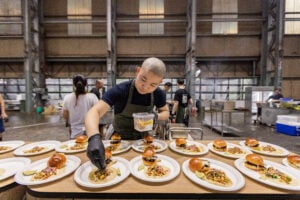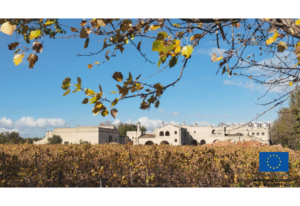We are what we eat – literally. As we consume food, it becomes a part of us, sculpting away at the physical shape of our bodies. But food also binds us to others. Food takes us back in time, linking us to the recipes and rituals of previous generations. Food ties us to our family, and to our wider communities. And food also transports us to into other worlds, offering us tastes of unknown culture and traditions.
As our cover story takes you on a culinary journey through Vietnam, one bite at a time, discover the stories and history of the nation’s unique dishes
Chuc An Ngon!
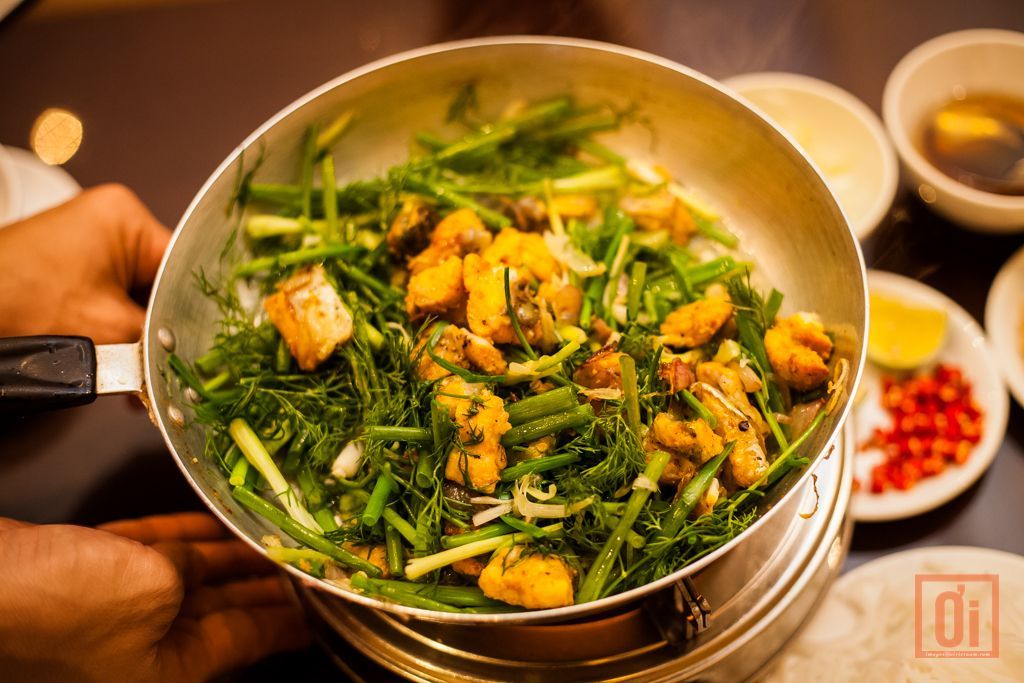 Cha Ca La Vong from Ha noi – This iconic dish from Hanoi is said to have originated over a hundred years ago in a restaurant in Hanoi’s Old Quarter that shares, and still bears, the same name. “It was invented by the Doan family and they gave it the name La Vong,” says Hong, the owner of Papaya restaurant. La Vong is the Vietnamese name for Lu Shang, the Chinese military strategist of the 11th century B.C. who helped overthrow the Shang Dynasty. “They gave it his name because they had a small idol of La Vong in their restaurant. All the people who came to eat there saw the idol and began calling it La Vong’s restaurant,” she further explains.
Cha Ca La Vong from Ha noi – This iconic dish from Hanoi is said to have originated over a hundred years ago in a restaurant in Hanoi’s Old Quarter that shares, and still bears, the same name. “It was invented by the Doan family and they gave it the name La Vong,” says Hong, the owner of Papaya restaurant. La Vong is the Vietnamese name for Lu Shang, the Chinese military strategist of the 11th century B.C. who helped overthrow the Shang Dynasty. “They gave it his name because they had a small idol of La Vong in their restaurant. All the people who came to eat there saw the idol and began calling it La Vong’s restaurant,” she further explains.
Distinctive is the first word that leaps to mind when describing this culinary achievement. The incorporation of dill accounts for much of it. Dill is abundant in cha ca La Vong, which is unusual as it’s seldom found in Southeast Asian cuisine. Many believe that it’s the copious amount of dill in this dish that may prevent it from being more popular in Vietnam.
Accompanying the dill is turmeric, shrimp paste, and, of course, fish sauce, which combine with chilies, noodles, and a host of fresh herbs that light up the fish with flavor.
Where to tr y it : Cha ca La Vong 36 Ton That Thiep, D1
Cao Lau from Hoi An – In a region brimming with culinary triumphs, cao lau is the dish. Made with noodles, pork, and greens, it is held that the unique flavor of cao lau comes from a special elixir used to prepare the noodles. It is comprised of lye and water drawn from ancient Cham wells hidden around Hoi An and Quang Nam provinces.
Kieu, who hails from Hoi An and used to help her grandmother run a cao lau stand, claims: “It is because of this brew that some say only cao lau from Hoi An is authentic; all other incarnations use water that comes from somewhere else.”
Other explanations that don’t carry such an urban legend tone propose that the town’s origins as a Japanese trading center in the 17th century prior to the Chinese establishment helped influence the dish. The similarity between cao lau and soba noodles lends some credence to this. There is no definitive explanation on the history of this storied dish, but luckily that doesn’t prevent anyone from enjoying it.
One feature that people who try the dish take note of is the texture. “Cao lau noodles are firm and chewy, like the Japanese soba noodles, instead of the typically soft rice noodles found in other Vietnamese noodle dishes,” says Kieu.
Although cao lau is considered a jewel in Vietnam’s culinary crown, many advise against trying to create it at home. Because of the effort required to prepare all the ingredients, the undertaking is quite extravagant. It’s better to leave it to the pros.
Where to tr y it :Quan Fai Fo 139 Le Thi Hong Gam, D1 3822 5236
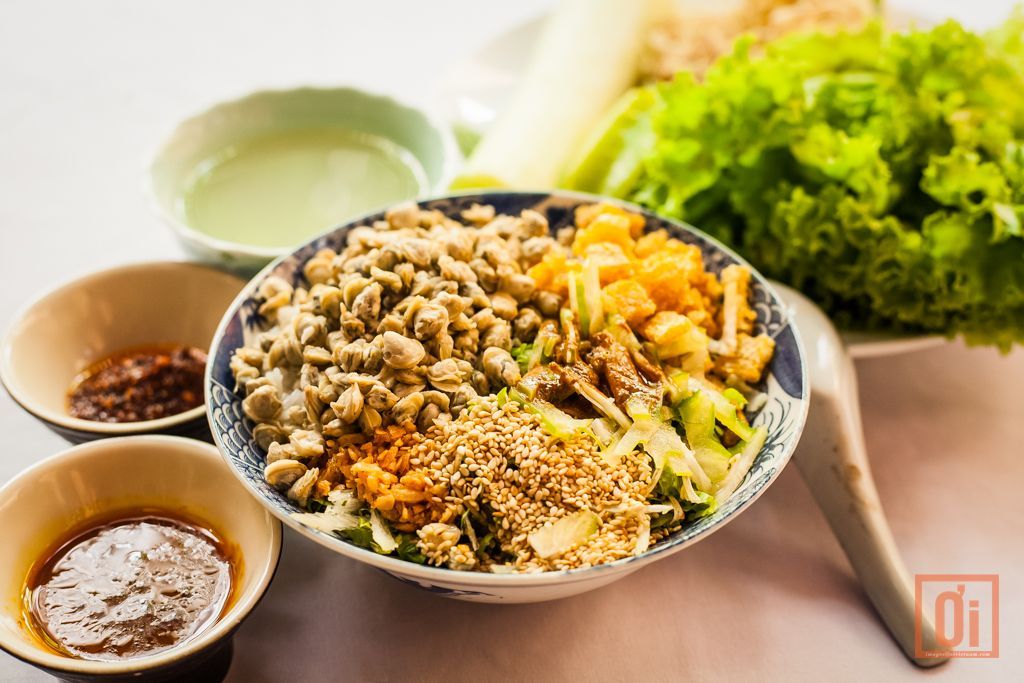 Com Hen from Hue -Hue has reverent status among the many cities and regions of Vietnam. Home to ancient kings and meals fit for them, it’s ironic that one of Vietnam’s most loved dishes is far from the imperial cuisine for which Hue is known. Com hen, which means ‘rice and baby clams’, is a peasant dish that was a staple for the multitudes of poor in the Hue region who rely on the abundance of clams found in the Huong River and the produce they grow in their own gardens to feed themselves.
Com Hen from Hue -Hue has reverent status among the many cities and regions of Vietnam. Home to ancient kings and meals fit for them, it’s ironic that one of Vietnam’s most loved dishes is far from the imperial cuisine for which Hue is known. Com hen, which means ‘rice and baby clams’, is a peasant dish that was a staple for the multitudes of poor in the Hue region who rely on the abundance of clams found in the Huong River and the produce they grow in their own gardens to feed themselves.
“Poor people started going to the island of Con Hen a long time ago to catch clams,” explains Tam, the proprietor of Tib Restaurant that specializes in Hue cuisine. “They would use the clams along with the things they grew in the garden.”
One of the more complicated dishes offered in Vietnam, it includes a multitude of ingredients that produces a harmony of pleasing aromas—rice, onions, and grease—and tastes that include sweet, bitter, sour, salty, buttery, and spicy. The ingredients in com hen are the clams, a variety of greens, rice, and a slew of spices and sauces. “The clams are what make it special, of course, but it’s the sate and the shrimp paste that turn it into what it is, a delicious dish that’s been enjoyed for over 200 years,” Tam says.
Where to tr y it :Tib 187 Hai Ba Trung, D1
Banh Trang Trang Bang from trang Bang – Forty kilometers northwest of Ho Chi Minh City lies the tiny district of Trang Bang, population less than 200,000. Best known as a blip along the road to the wildly popular religious sites of the Cao Dai Temple or the Black Virgin Temple in Tay Ninh, Trang Bang is now known as the production center for all kinds of rice paper. The district of Trang Bang reportedly has up to a thousand banh trang ‘factories’ ranging from the mom and pop enterprises making the wraps out of their own houses, to village collectives where each family looks after one link in the process.
Out of these many production centers, a few hundred are dedicated to the making of the rice paper named after the region, banh trang phoi suong Trang Bang (dew wetted rice paper). This labor-intensive wrap starts off with two layers of rice and tapioca flour, thinly steamed, one on top of the other, over a stretched piece of canvas. Once dry, the rice paper is grilled over an open flame, making it puffy and opaque. In the early morning dew, the paper is briefly left out to soak up the elements. Sealed in bags, the lightly salty rice paper remains pliable and chewy for about a week, without needing to be wet before use.
Hong Em and her family have been making rice paper for over 20 years in their small house. “With just three of us, we can make 500-700 every day. We only do the steaming and grilling, though. We then turn it over to another family to finish the process,” she says. When asked why it’s become a Trang Bang specialty, Hong Em’s simple roots show through. “Because it’s good. It’s different,” she posits succinctly.
Traditionally, this dew wetted rice paper is used to wrap slices of boiled pork, crunchy pickled vegetables and vermicelli, all dipped in either fish sauce or fermented shrimp sauce. But the highlight for many is actually the raw herbs that accompany the dish. With odd names like water dropwort, perill and Spanish Flag, the dozen or so herbs grown predominantly in the area represent the full range of sour, sweet, astringent and even spicy. Textures are also varied with some leaves being hard and waxy while others are eaten stalk and all.
Because of the many of ingredients involved, banh trang Trang Bang is most often eaten out, commonly enjoyed with rice wine or an icy cold beer.
Where to tr y it : Banh Trang Trang Bang Hoang Ty 106 Cao Thang, D3 3833 2077
 Com Tam from Ho Chi Minh City – With Saigon being Vietnam’s melting pot, where almost every regional dish from around the country can be had, it’s ironic that locals would be hard pressed to name a dish that is uniquely Ho Chi Minh City. Perhaps a truer indicator, though, is to travel to other parts of the country and suddenly realize what is conspicuously missing – the familiar com tam stands that vie for space on nearly every Saigon street corner.
Com Tam from Ho Chi Minh City – With Saigon being Vietnam’s melting pot, where almost every regional dish from around the country can be had, it’s ironic that locals would be hard pressed to name a dish that is uniquely Ho Chi Minh City. Perhaps a truer indicator, though, is to travel to other parts of the country and suddenly realize what is conspicuously missing – the familiar com tam stands that vie for space on nearly every Saigon street corner.
Hien, a recent Hanoi transplant explains why the simple rice and pork dish, so wildly popular in Saigon, simply hasn’t caught on in the North. “In Hanoi, we’re not used to eating rice for breakfast. It’s mainly pho and other soups, or steamed foods. We also don’t eat a lot of meat for breakfast. And the sauce is too sweet for our taste. When it’s sold in Hanoi, the recipe has to be reworked.”
The story of the origins of com tam as a peasant dish is widely known. Born of necessity in the farmlands of the south, workers kept the broken grains of rice unsuitable for sale and served it up with pork skin, one of the cheapest cuts of the animal, tossed with powdered roasted grains of rice for a smoky flavor, all doused in a sweet concoction of fish sauce. With students, travelers and families looking for a better life in the city, the quintessential comfort food made its way to the big stage.
A fancy version of humble com tam even made headlines last year when American born Vietnamese home cook, Christine Ha, used it to win Season 3 of the reality cooking show US Masterchef. Her dish was an elevated rethink of braised pork belly with rice, with the addition of crispy kale and maitake mushrooms, and topped with the familiar fried egg.
The basic components of com tam are simple: rice and pork (ribs, chops or shredded). Typical add-ons include pork skin called bi, an egg-based quiche with ground pork and tree ear mushrooms known as cha and a fried egg, trung chien, all topped with a spoonful of scallion oil.
Where to tr y it : Com Tam An La Ghien (97B Nguyen Trai, D1) restaurants serve up 20 variations on the dish, some traditional, some with a modern twist, like the addition of sate or salt-crusted pork.
Hu Tieu Nam Vang from Mekong Delta Region – If you ever find yourself deep down south in towns like Soc Trang or Tra Vinh, you may be surprised to find some of the residents with slightly darker skin and features unlike your typical Vietnamese including wider noses, rounder eyes and the occasional curly hair. These are Khmer Krom – ethnically Cambodian but who in most cases, have lived in Vietnam for decades, even generations.
While Cambodian cuisine hasn’t exactly made an entrance on the world’s culinary stage, one dish in particular is enjoyed throughout the south in Vietnam – hu tieu Nam Vang or Phnom Penh style noodle soup. It has been good naturedly called an international dish – created by Cambodians, refined by the Chinese community there and served up Vietnamese style. In its essence, hu tieu Nam Vang is a pork broth with chewy tapioca noodles, served up with ground pork and other meats such as offal, poached shrimp and sliced pork. The Vietnamese version also has a boiled quail egg and herbs like Chinese parsley, chives and bean sprouts, all topped with deep fried onions. The dish can also be ordered dry, with all the noodles and meat mixed with a dash of soy sauce and chili sauce and the broth served on the side, to be sipped while slurping the dry ingredients. The Chinese version is flavored with soy sauce, while the actual version served in Cambodia is sweeter.
Ly, and her husband Muoi, own Lien Hua, one of the city’s most well-known hu tieu Nam Vang eateries, selling an average of 300 bowls a day. Ly is second generation Cambodian, with her parents emigrating to Vietnam in 1975. They brought along with them the family recipe, opening their first restaurant when she was 10. “We had restaurants in every house we rented, near Le Thanh Ton and Nguyen Hue. Now we own five shops all over town.” While Ly only speaks a few words of Khmer, she’s made the Cambodian soup for decades. “I’ve eaten it in Phnom Penh and it’s different from the kind served here. It’s sweet, but the sweetness comes from sugar and MSG. In my shop, the sweetness of the broth comes from stewing the bones from 4am every morning. The beauty of great hu tieu Nam Vang is in the chewiness of the noodles, the clarity of the broth, the freshness of the shrimp poached to order and the different cuts of pork.”
Where to tr y it : Hu Tieu Nam Vang Lien Hua 321 An Duong Vuong, Q5
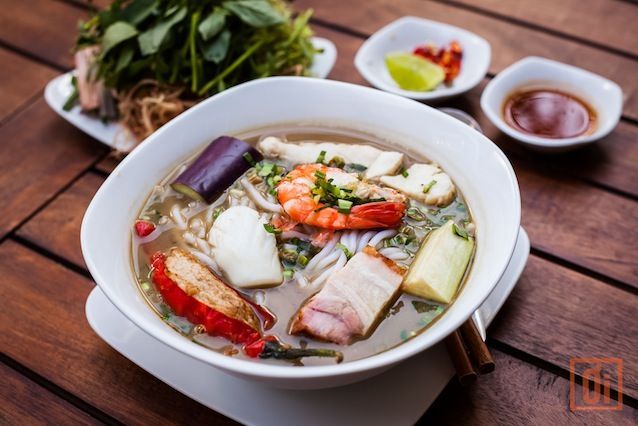 Lau Mam from Chau Doc – If you find the smell of nuoc mam noxious, you’ve obviously never tried lau mam. A specialty of the Mien Tay Nam Bo region of Vietnam, a vast area of southern Vietnam bordered by Cambodia to the west, the Gulf of Thailand to the south and the East Sea, lau mam is essentially a seafood hot pot with fermented fish as its base, eaten with vermicelli noodles, a heap of herbs and blossoms, and sides of sliced cucumbers,eggplant and green banana, all dipped in tamarind fish sauce. It’s a visual, if not olfactory feast, with the bright green of the herbs, the yellow of the squash blossoms, the purple of the eggplant and the pink flesh of the fish waiting to be cooked in the reddish-orange broth. It typifies down home cooking because all the ingredients are locally plentiful, found in ponds, fields, rivers and home gardens.
Lau Mam from Chau Doc – If you find the smell of nuoc mam noxious, you’ve obviously never tried lau mam. A specialty of the Mien Tay Nam Bo region of Vietnam, a vast area of southern Vietnam bordered by Cambodia to the west, the Gulf of Thailand to the south and the East Sea, lau mam is essentially a seafood hot pot with fermented fish as its base, eaten with vermicelli noodles, a heap of herbs and blossoms, and sides of sliced cucumbers,eggplant and green banana, all dipped in tamarind fish sauce. It’s a visual, if not olfactory feast, with the bright green of the herbs, the yellow of the squash blossoms, the purple of the eggplant and the pink flesh of the fish waiting to be cooked in the reddish-orange broth. It typifies down home cooking because all the ingredients are locally plentiful, found in ponds, fields, rivers and home gardens.
Nestled just over the border from Cambodia and with easy access to the Hau River, the city of Chau Doc has emerged as the fermented fish capital of Vietnam. The broth for lau mam starts with sticky fermented fish paste made from freshwater carp or minnows, either from the river or the rice fields. After the fish is cleaned and the guts removed, it’s salted and left in barrels to cure for about a month. The fish is then cleaned and dredged in rice grains, roasted and crushed into powder. Carefully laid out in rows, the fish is again put into barrels, this time soaked in fish sauce for another two to six months. Finished off with spices and palm sugar, the fermented fish paste is ready to be the base for a number of pungent dishes.
Khanh, the owner of Lau Mam Quan Vy, acknowledges the very much acquired taste and smell of her specialty. “After we buy two different kinds of fish paste from Chau Doc, we bring it back to the shop and cook it down until there’s nothing left but bones. We’ll add in our own ingredients, like pineapple, lemongrass and ngai bun (a regionally grown root related to the galangal). I’ll have to admit, though, that it’s pretty smelly. So we cook it at night or early in the morning before customers come. We also have a pretty big exhaust fan!”
Both sides of Khanh’s family come from the Nam Bo region, so she grew up eating it. “You can’t make it for one. It’s a dish meant to be shared. My mom would make it every time we had a family get together.”
Where to tr y it : Lau Mam Quan Vy 190/19 Su Van Hanh, D5 3835 4815
Goi Ca Trich from Phu Quoc – To foodies , terms like sashimi and carpaccio (raw protein sliced thinly) and ceviche (raw seafood marinated in citrus juices) are nothing new. But what may surprise some is that Phu Quoc, Vietnam’s largest island located just eight miles off the Cambodian coastline, has its own version of carpaccio meets ceviche in goi ca trich. In Vietnamese, the word goi refers to food that is rolled up and ca trich is a small schooling fish and part of the sardine family.
The dish itself is simple. Start with the freshest sardinellas you can find, filleted, but with its silvery skin left on. It’s then tossed with homemade vinegar, a concoction of bananas, sugar cane, guava, sugar and water, essentially using acid to cook the fish until the flesh begins to turn white on the outside while still pink in the middle. Some who prefer it more well done will heat the vinegar first. Lime juice may also be used instead of vinegar. Then it’s rolled in damp rice paper, along with moist shredded coconut, slivers of onion and shallots and wild herbs, served with a dipping sauce made of Phu Quoc fish sauce, chilies, garlic and crushed peanuts.
Dung, a native of Phu Quoc and now a cook at Liberty Central, remembers the dish of his youth. ” I remember it being difficult to roll because of all the ingredients, so my parents would roll it for me even into my teens!” he recalls with an embarrassed smile. “It’s great because it doesn’t cost much to make, but the dish has everything. All the flavors are there, from the fattiness of the coconut flesh, the sweetness of freshly caught fish and the sourness of the dipping sauce.”
Best enjoyed as an appetizer along with a glass of Phu Quoc rose myrtle wine (ruou sim), the intoxicatingly delicious combination of Phu Quoc sardinellas and Phu Quoc fish sauce is even extolled in Vietnamese proverb as being good enough to make men forget their own wives because of it. Phu Quoc sardinellas aren’t widely available in Saigon’s markets so the dish is best sampled at one of the few Phu Quoc specialty restaurants around town.
Where to tr y it : Phu Quy 46/6B Tran Van Dang, D3 090 753 3056




